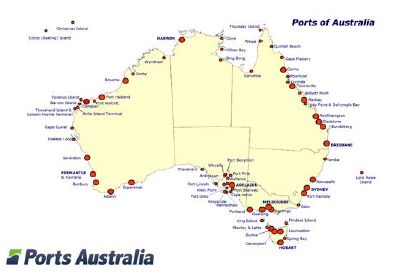In recent years, the economic growth and success of Australia has been inextricably linked to a boom in the mining and resources sector. Minerals are Australia's largest export. Apart from the rise of oil and gas mining and production, onshore mining in the form of iron ore, coal and other metals and minerals has grown exponentially. In particular, Australia now holds the title as the world's largest exporter of iron ore and black coal respectively. This briefing explores the issues surrounding the location of these resources and the export of ore, the ownership and control of the logistics chain, the feasibility of the infrastructure and what infrastructure may be required. We also consider some leading pit to port projects in Australia.
Location of deposits and the export of resources
Most of the country's iron ore deposits and coal basins are located in remote areas far from major population centres.
According to the Bureau of Resources and Energy Economics, 93% of the country's identified iron ore resources (totalling some 64 billion tonnes) occur in Western Australia, with the major deposits found in the Hamersley Province in the Pilbara (Northwest of the State), making it one of the world's major iron ore provinces.
As for black coal, over 96% of these resources occur in New South Wales (Hunter Valley and Newcastle coalfields) and Queensland (Bowen, Callide, Surat, Moreton and Galilee Basins).
Most of the minerals and metals mined in Australia are destined for export. The largest importers of Australian minerals and metals are China, Japan, South Korea and India, but coal is also exported to Europe and the Americas.
Given that resource deposits are generally located many kilometres inland, extensive rail infrastructure is required to deliver those commodities to ports efficiently for bulk export.
Given the distance from major cities, there are generally no existing rail networks or port facilities, which can be utilised by prospective miners. Accordingly, mining companies have had to invest in their own pit to port infrastructure to support the export of their commodities.
In the case of both iron ore and coal, dedicated ports or berths have been developed or expanded. Most iron ore exports currently take place through Port Hedland, Dampier and Cape Lambert, with smaller quantities exported through Geraldton and Esperance in Western Australia. In the case of coal, most exports take place through Newcastle and Port Kembla in New South Wales, and Hay Point, Gladstone and Abbot Point in Queensland.

Ownership and control of the logistics chain
The large capital investment required for such an undertaking means that a company will only undertake the construction of pit to port infrastructure if there is no other feasible alternative or there are overwhelming benefits associated with the ownership and control of its own logistics chain.
Quite apart from the mining and mineral processing infrastructure, the logistics chain may involve the construction of access roads, air strips, mining camps, a power plant, water treatment plants, railway or rail spurs with train loaders and unloaders, and a port or port expansion in the form of new berths or terminals, all to support one or more mines.
Many a court challenge has been mounted by new entrants to the market seeking to gain third party access to the closely guarded rail and port infrastructure of established players. This course of action has not proved successful in Western Australia to date.
Major miners want the certainty of control of the logistics chain, with only their rolling stock and freight being carried on their privately owned railways in what are 24 hour/day operations. This ensures that there are no impediments to their ore reaching the market, no demurrage payable and that maximum returns are achieved.
Where miners are operating under State Agreements, are subject to the Railways (Access) Code in Western Australia or the laws governing access to infrastructure in other states, there may be a requirement for those parties to facilitate third party access to their rail infrastructure.
Rail owners can be required to accommodate proponents on existing infrastructure, but only insofar as capacity constraints allow. In the case of the Code, proponents may request a rail owner to undertake an extension or expansion of an existing railway if it can be done in a technically and economically feasible way and the expansion is consistent with the carrying on of safe and reliable rail operations on the route.
What has tended to happen is that capacity constraints on the railways of the largest miners have denied third parties the opportunity of access. In limited instances, those companies will freight ore on behalf of smaller miners (for example, FMG for BC Iron), but the process is controlled by the rail owners and is managed to fit around their own operational requirements.
If access cannot be negotiated with an existing rail owner, the only alternative for prospective market entrants is to build their own rail infrastructure. However, with tightly held tonnage allocations or berths at major ports, new or expanded port facilities may also be required.
The feasibility of pit to port infrastructure
The feasibility of such an undertaking is a major concern. An assessment of the commercial viability of mining a deposit must take into account the value and market potential of the mined ore, the full costs of developing the mine including geology, mine planning, and processing and the cost of associated plant and infrastructure, together with the cost of finance to undertake the project. Where a new railway and port is required, or even just a rail spur to an existing railhead or a new berth within an existing port, the costs are likely to be measured in the hundreds of millions, if not billions, of dollars.
The supply of equipment and the transport of ore make up some of the biggest outlays for a mining company. As deposits are being exploited hundreds of kilometres inland, the percentage of development costs associated with transport, power and water infrastructure is likely to far exceed the costs of mining plant, equipment and machinery, which have traditionally made up the bulk of mine development costs. Where distance is involved, rail haulage will be a cheaper option than road haulage in the long-term.
The economics of the construction and operation of pit to port infrastructure are central to the viability of many large resource projects.
What infrastructure will be required?
The construction project will be a complex one involving multiple sites and interfaces between the mining operations, rail, port facilities and shipping vessels.
Early construction work will generally involve the construction of access roads and an airstrip at the principal mine site. These will be extended to haul roads and site roads at both the mine and port and along the rail corridor.
As part of its mining infrastructure, a company will typically employ large haulage trucks and/or conveyors to haul ore or minerals to crushing, scrubbing, screening or treatment plants. The ore will then be transported by rail to port. In some instances the ore is further crushed, screened or blended at the port.
The railway will have to be planned and constructed to support heavy haulage trains of particular lengths and to accommodate particular scheduling. The ore freight trains used in Australia comprise some of the largest consists and tonnage loads in the world. The rail works will typically include marshalling, service and maintenance yards, train loaders, rail loops and sidings, culverts, bridges, signalling and communications and train unloaders, conveyors and stackers at the port.
A port will have to be designed complete with shipping channel(s), marine structures such as wharves, jetties, load-out facilities, berthing dolphins, navigational aids and harbour walls. The onshore port or terminal facilities would include offices, water, power, lighting, communications and storage or stockpiles. Once again, the design will be influenced by many factors, including the proposed export volumes, size and frequency of export vessels to be accommodated and other logistics.
Heavy haul rolling stock will have to be designed and constructed, often overseas for shipment to Australia.
Leading examples of pit to port operations in Australia
The largest iron ore producers in Western Australia, BHP Billiton, Rio Tinto and Fortescue Metals Group, own and operate private pit to port infrastructure.
BHP Billiton operates the Newman Line (426km) and Goldsworthy line (208km) from its mines near Mount Newman and Mount Goldsworthy and along the route of those railways. Ore is transported by rail to Port Hedland Rio Tinto and its wholly owned subsidiary, Hamersley Iron, operate the Hamersley and Robe River lines, which total more than 1,100km. Rio Tinto transports ore from its mines near Tom Price, Paraburdoo, Yandicoogina and Hope Downs to Dampier for export and from its Robe River and West Angelas mines to Cape Lambert for export.
Roy Hill Holdings (in which Hancock Prospecting owns a 70% share) is currently undertaking the construction of the new AUD 10 billion Roy Hill pit to port project, which will include a 344km railway and two new berths at Port Hedland.
Fortescue Metals Group operates a 310km long railway from its Chichester Hub (Cloud Break, Christmas Creek mines) to private berths at Anderson Point in Port Hedland. More recently a 129km rail spur has been constructed to connect FMG's Solomon Hub (Firetail, Kings Valley mines) to its main railway line to Port Hedland. These large scale expansions have cost many billions of dollars.
Other iron ore pit to port logistics chains involve Geraldton (including Oakajee) and Esperance Ports. The development of new rail and iron ore export facilities at Anketell Point some 30km east of Karratha and the existing port of Dampier is currently being planned.
According to the April 2014 "Resource and Energy Major Projects" report published by the Australian Government's Bureau of Resources and Energy Economics, iron ore projects with a combined value of over AUD 20 billion and coal projects with a combined value of over AUD 15 billion are in the Publicly Announced Stage. In addition, iron ore projects with a combined value of over AUD 29 billion and coal projects with a combined value of over AUD 50 billion are at the Feasibility Stage in Australia. This will lead to further pit to port developments or expansions over the coming years.
The content of this article is intended to provide a general guide to the subject matter. Specialist advice should be sought about your specific circumstances.


